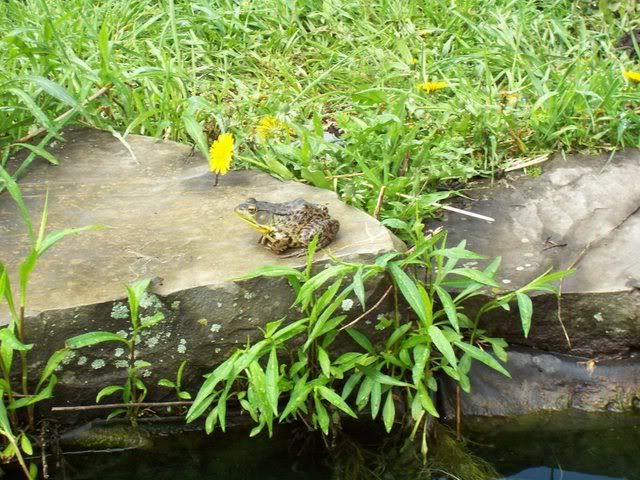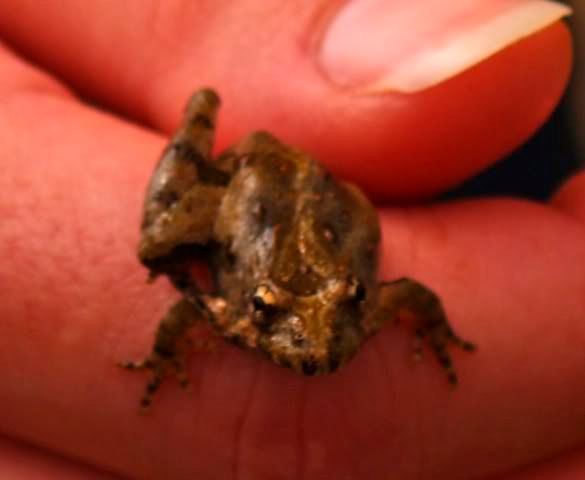Frogs!
- Matt
- President

- Posts: 13374
- Joined: Sun Apr 23, 2006 5:01 pm
- Camera Model: Olympus OMD EM-1 m1, m2; Panasonic GM5, Osmo Pocket
- Location: Rochester, NY
- Contact:
The frogs page has been posted to the Wildlife section.
- cbobcat49
- Moderator

- Posts: 1807
- Joined: Wed May 24, 2006 7:19 pm
- Camera Model: Olympus Stylus 400
- Location: Tonawanda, NY
- Contact:
The audio links are a nice touch. My wife freaked and thought there were frogs right outside. (The back yard actually is pretty swamplike this time of year.)
-
champy1013
- Lead Contributer

- Posts: 708
- Joined: Sun Apr 10, 2011 12:45 pm
- Camera Model: Canon EOS 5D Mark IV
- Location: Skaneateles
You know - I've heard Chorus frogs where I live - in Onondaga County - and even though they don't fall into the range that you marked on your map - I'm pretty sure that they're here
- Brenda
- VIP II

- Posts: 2740
- Joined: Mon Apr 02, 2007 2:01 pm
- Camera Model: Canon PowerShot SX20 IS
- Location: Lodi
My reptile and amphibian field guide doesn't even show them in NY. It also refers to the same species as the Northern Chorus Frog, which is the name that I learned them by, but information will vary depending upon the source. They are also a species that is noted to be particularly wary; more often heard than seen, so depending upon who compiled the information for the distribution map...I would certainly assume that you have them, as we have them here and you're not that far away, nor are they habitat specific, beyond wet areas, according to my information. However, I do believe that they are a species that is in decline. The bottom line is, as my professors often said, the problem with distribution maps is that the critters don't read them! A side note: I was taught that their trill sounds like running a fingernail over the teeth of a comb.
Finger Lakes Mill Creek Cabins
http://www.fingerlakescabins.com
http://www.fingerlakescabins.com
- Matt
- President

- Posts: 13374
- Joined: Sun Apr 23, 2006 5:01 pm
- Camera Model: Olympus OMD EM-1 m1, m2; Panasonic GM5, Osmo Pocket
- Location: Rochester, NY
- Contact:
Chances are with the weather like is was last summer and coming up this summer, frogs are going to have a good ride. I wouldn't be surprised if they doubled their habitats last summer.
- Brenda
- VIP II

- Posts: 2740
- Joined: Mon Apr 02, 2007 2:01 pm
- Camera Model: Canon PowerShot SX20 IS
- Location: Lodi
This male green frog was kind enough to pose for me by my garden pond a few minutes ago.


Finger Lakes Mill Creek Cabins
http://www.fingerlakescabins.com
http://www.fingerlakescabins.com
- Matt
- President

- Posts: 13374
- Joined: Sun Apr 23, 2006 5:01 pm
- Camera Model: Olympus OMD EM-1 m1, m2; Panasonic GM5, Osmo Pocket
- Location: Rochester, NY
- Contact:
Study: Farms Fuel Frog Deformities
Frog-deforming infections caused by tiny parasites are increasing because of North American farms' nutrient-rich watershed, a new study shows.
The excess nitrogen and phosphorus found in farm runoff causes more algae to grow, which increases snail populations that host microscopic parasites called trematodes, said Pieter Johnson, a water scientist at the University of Colorado in Boulder.
"This is the first study to show that nutrient enrichment drives the abundance of these parasites, increasing levels of amphibian infection and subsequent malformations," said Johnson.
Johnson noted that he and his colleagues' work, which is detailed in the Sept. 24 issue of the Proceedings of the National Academy of Sciences, could also explain "a wide array of diseases potentially linked to nutrient pollution."
Frog species also are vanishing from Earth in the past few decades for reasons that are difficult to tease apart, including habitat loss, global warming and emerging diseases such as one caused by chytrid fungus. Nutrient pollution and limb malformations also contribute, Johnson said.
A worldwide study of more than 6,000 species of amphibians recently concluded that 32 percent were threatened and 43 percent were declining in population.
History of deformities
Deformed frogs first gained international attention in the mid-1990s, when a group of schoolchildren discovered a pond where more than half of the leopard frogs had missing or extra limbs, Johnson said. Since then, widespread reports of deformed amphibians have led to speculation that the abnormalities were being caused by pesticides, increased ultraviolet radiation or parasitic infection.
Parasite infection is now recognized as a major cause of such deformities, but the environmental factors responsible for increases in parasite abundance have largely remained a mystery.
"What we found is that nitrogen and phosphorus pollution from agriculture, cattle grazing and domestic runoff have the potential to significantly promote parasitic infection and deformities in frogs," Johnson said.
The trematode life cycle involves three host species. The tiny parasites form cysts in the developing limbs of tadpoles, causing missing limbs, extra limbs and other malformations, Johnson said. Aside from this stage and an infectious one in snails and the cyst stage in frogs, predators complete the trematode life cycle by eating infected frogs and spreading the parasite back into the ecosystem.
Nutritious problem
To discover the link between farms and the trematode infections, Johnson and his team built 36 artificial ponds similar to farm stock tanks, where frogs and salamanders often breed and deposit their eggs.
The researchers then stocked each tank with snails and green frog tadpoles and, in addition to adding nutrients, they dropped in parasite eggs. In ponds with added nutrients, Johnson said, the total mass of snails was 50 percent greater and parasite egg production was eight times as great.
The infection rate in frogs rose between two to five times in those tanks, he added.
"We were able to watch nutrient pollution move through the life cycle of the parasite as it cascaded through the food web," he said. "Since most human diseases involve multiple hosts, understanding how increased nutrient pollution affects freshwater and marine food webs to influence disease is an emerging frontier in ecological research."
http://www.livescience.com/environment/ ... frogs.html
Frog-deforming infections caused by tiny parasites are increasing because of North American farms' nutrient-rich watershed, a new study shows.
The excess nitrogen and phosphorus found in farm runoff causes more algae to grow, which increases snail populations that host microscopic parasites called trematodes, said Pieter Johnson, a water scientist at the University of Colorado in Boulder.
"This is the first study to show that nutrient enrichment drives the abundance of these parasites, increasing levels of amphibian infection and subsequent malformations," said Johnson.
Johnson noted that he and his colleagues' work, which is detailed in the Sept. 24 issue of the Proceedings of the National Academy of Sciences, could also explain "a wide array of diseases potentially linked to nutrient pollution."
Frog species also are vanishing from Earth in the past few decades for reasons that are difficult to tease apart, including habitat loss, global warming and emerging diseases such as one caused by chytrid fungus. Nutrient pollution and limb malformations also contribute, Johnson said.
A worldwide study of more than 6,000 species of amphibians recently concluded that 32 percent were threatened and 43 percent were declining in population.
History of deformities
Deformed frogs first gained international attention in the mid-1990s, when a group of schoolchildren discovered a pond where more than half of the leopard frogs had missing or extra limbs, Johnson said. Since then, widespread reports of deformed amphibians have led to speculation that the abnormalities were being caused by pesticides, increased ultraviolet radiation or parasitic infection.
Parasite infection is now recognized as a major cause of such deformities, but the environmental factors responsible for increases in parasite abundance have largely remained a mystery.
"What we found is that nitrogen and phosphorus pollution from agriculture, cattle grazing and domestic runoff have the potential to significantly promote parasitic infection and deformities in frogs," Johnson said.
The trematode life cycle involves three host species. The tiny parasites form cysts in the developing limbs of tadpoles, causing missing limbs, extra limbs and other malformations, Johnson said. Aside from this stage and an infectious one in snails and the cyst stage in frogs, predators complete the trematode life cycle by eating infected frogs and spreading the parasite back into the ecosystem.
Nutritious problem
To discover the link between farms and the trematode infections, Johnson and his team built 36 artificial ponds similar to farm stock tanks, where frogs and salamanders often breed and deposit their eggs.
The researchers then stocked each tank with snails and green frog tadpoles and, in addition to adding nutrients, they dropped in parasite eggs. In ponds with added nutrients, Johnson said, the total mass of snails was 50 percent greater and parasite egg production was eight times as great.
The infection rate in frogs rose between two to five times in those tanks, he added.
"We were able to watch nutrient pollution move through the life cycle of the parasite as it cascaded through the food web," he said. "Since most human diseases involve multiple hosts, understanding how increased nutrient pollution affects freshwater and marine food webs to influence disease is an emerging frontier in ecological research."
http://www.livescience.com/environment/ ... frogs.html
-
champy1013
- Lead Contributer

- Posts: 708
- Joined: Sun Apr 10, 2011 12:45 pm
- Camera Model: Canon EOS 5D Mark IV
- Location: Skaneateles
Down in Virginia this weekend, stumbled across this little guy. So very fast he was!

One thing we immediately noted was he looked like a froad (frog/toad combo)
Here's the pic from the virginia state website


One thing we immediately noted was he looked like a froad (frog/toad combo)
Here's the pic from the virginia state website



